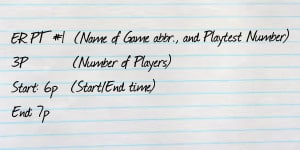
Dear Diary,
Among nerds, there are the board gamers. Among the board gamer nerds, there are board game designers. And among those nerds, you have the few, the proud, who, in an ultimate display of board game nerdiness… keep playtest journals.
Now, before I go and exert too much effort in coming up with some “Diary of Catan-ne Frank” pun or something, let’s first discuss the “why” of keeping a journal.
WHY?
- Remember the changes you made last time. – When playtesting really picks up speed, you may make many changes to the game in one session. If you write these down and save them, you don’t have to worry about remembering them next time you pull out the prototype.
- Remember your thoughts mid-game. – Jotting notes in your journal as you play will help (1) not forget any thoughts by the end of the game, and (2) focus your attention on playing the game.
- Monitor length of game. – A simple note of the start time and end time will do, but some games might benefit from noting the duration of each phase of the game (early, mid, and late). In a playtest, try to get through the entire game without making any changes. It will be easier to track the effects of changes on game duration.
- Prove your efforts to publishers/commissioner. – It’s not likely that a potential publisher will demand to see your playtest journal, but it would certainly give your credentials a shot in the arm if the topic came up. However, if you are doing commissioned design work, a playtest journal is a must to show where those hours are going, and how the game is progressing.
- Sell your journal for millions once the game hits it big. – Isn’t this the real reason we hang on to our notes for years?
Convinced? Didn’t need convincing? Read on for the all-important “how”.
HOW?
I’ll start by saying that you should feel free to record and organize your playtest information in whatever way makes the most sense to you.
That said, each entry in my personal playtest journals starts with a header that looks something like this:

The meat of the entry falls under three headings:
- Set-up – For the first several playtests, list the entire set-up procedure. When your set-up becomes more standard, list only the changes to the standard set-up here.
- Results – Record the scores, take notes on how the mechanics played out, but also write down player’s impressions on how they felt their gameplay went.
- For Next Time – What new rules would have made that game better? Changes to set-up? Write anything you need to remember for next time.
Lastly, I usually have a catch-all category for questions to ponder, brainstorms to consider, and art design notes.
And that’s about it. You could get a lot more detailed and standardized. You can even purchase a pad of game design playtest sheets. However, though some might find it insightful to take notes in such a detailed, organized system, others might be paralyzed by it. The three or four categories above serve my needs to keep the playtests building on each other without taking excessive time. Here’s what the League has said on the topic of play test sessions.
Well, Diary, speaking of time, I think I have to go. Mom just finished my laundry, and you know how much I like warm tube socks. Until next time,
– Mike








